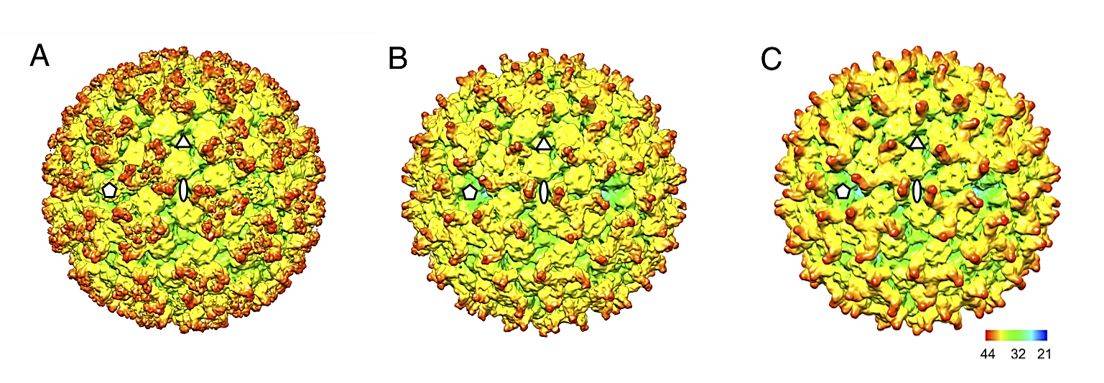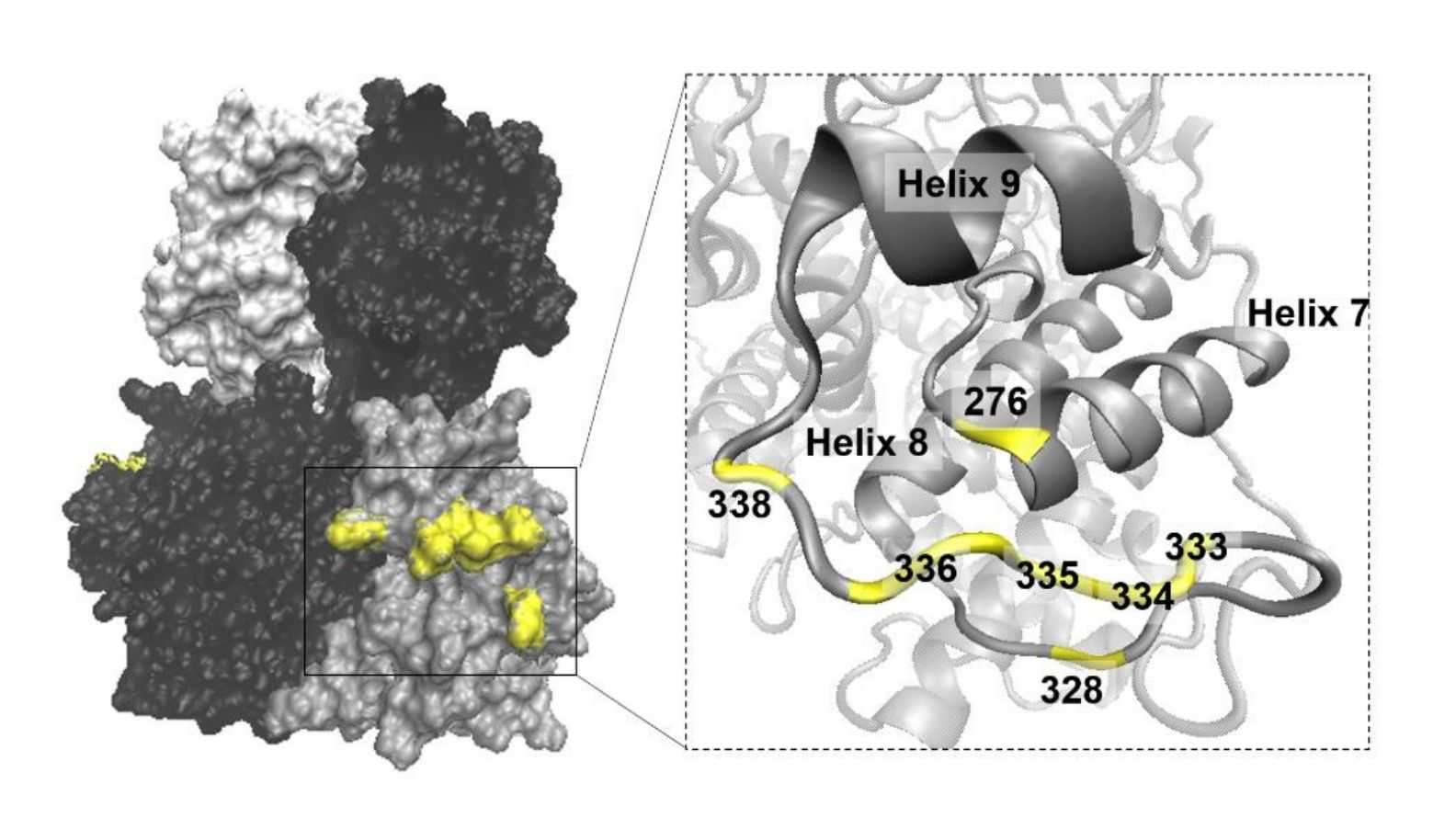Structural Research of African Horse Sickness Virus
African Horse Sickness (AHS) is a life-threatening hemorrhagic disease of equids characterized by respiratory and circulatory disturbances. It is caused by nine different serotypes of the circovirus AHS virus (AHSV). AHSV belongs to the genus Orbivirus in the family Reoviridae and has no envelope, consisting of two capsids. Its genome contains 10 double-stranded RNA fragments, and it is transmitted through the bloodstream and infects the lungs, spleen, and other lymphoid tissues. For the control of AHS, live attenuated vaccines (LAV) have been relatively successful, but there is a risk of virulence reversion. As a result, research has been initiated in recent years to develop new, more favorable recombinant vaccines that utilize viral vectors or virus-like particle technology.
 Figure 1. (A) AHSV-4 at 14.4-Å; (B) empty AHSV-7 tVP2 at 15.8-Å; (C) filled AHSV-7 tVP2 at 11.4-Å. (Manole V, et al., 2012)
Figure 1. (A) AHSV-4 at 14.4-Å; (B) empty AHSV-7 tVP2 at 15.8-Å; (C) filled AHSV-7 tVP2 at 11.4-Å. (Manole V, et al., 2012)
Structural Features of the African Horse Sickness Virus
AHSV particles are structurally complex and highly organized, envelope-free isometric particles with a diameter of approximately 80nm. the envelope-free virion has a quasi-icosahedral symmetry and consists of three concentric protein layers. The innermost layer encloses the AHSV genome, which consists of 10 linear dsRNA fragments encoding seven structural (four major and three minor) and five nonstructural proteins. Two major structural proteins, VP5 and VP2, form the outer shell layer, and two other major structural proteins, VP3 and VP7, as well as minor structural proteins, VP1, VP4, and VP6, form the AHSV core particle. The core is made rigid by 780 monomers of VP7, which is highly conserved among all serotypes and is the population-specific antigen currently used in diagnostic tests.
Progress in Structural Research on African Horse Sickness Virus
Using cryo-electron microscopy (cryo-EM) and three-dimensional image reconstruction, the researchers determined the structure of AHSV-4. The structure reveals three layers of AHS virions that surround the segmented genome and transcriptase complex. Of these, the VP2 spike is formed by trimerization of the central domains of three VP2 monomers, and the bases of each VP2 spike interact with a Q-type VP7 trimer. In recent years, research has revealed that the major core protein, VP7, is highly insoluble and spontaneously forms crystalline particles when expressed in vitro, posing a challenge to AHSV vaccine development. However, researchers have abrogated VP7 self-assembly by targeted mutagenesis to candidate amino acid regions on the surface of the VP7 trimer, providing new insights into the successful development of AHSV vaccines.
 Figure 2. Three-dimensional analysis of the location and secondary structure of the AHSV VP7 fixed-point mutagenesis region. (Bekker S, et al., 2022)
Figure 2. Three-dimensional analysis of the location and secondary structure of the AHSV VP7 fixed-point mutagenesis region. (Bekker S, et al., 2022)
AHSV virus-like particles have great potential in vaccine development. By providing the immune system with a safe and accurate characterization of the virus, AHSV VLPs help train the immune system to recognize and respond to AHSV, thereby protecting horses and other susceptible animals.
VLP-based vaccines are considered safe because they do not contain live virus particles. In addition, VLPs can be produced in large quantities and are designed to exhibit specific viral antigens for a targeted immune response. Creative Biostructure as a leading supplier of virus-like particles, offers high-purity virus-like particles (VLPs) products for use in the development of vaccines and antiviral drugs.
| Cat No. | Product Name | Virus Family | Source | Composition |
| CBS-V541 | African horse sickness virus-9 VLP (VP2; VP5; VP7; VP3 Proteins) | Reoviridae | Insect cell recombinant | VP2; VP5; VP7; VP3 |
| CBS-V542 | African horse sickness virus VLP (VP5; VP2; VP7; VP3 Proteins) | Reoviridae | Plant recombinant | VP5; VP2; VP7; VP3 |
| Explore All African Horse Sickness Virus VLP Products | ||||
In addition to VLP products, Creative Biostructure also offers viral structure analysis services. The focus of our services is to provide an in-depth analysis of the structure of AHSV, unraveling its complex molecular architecture and gaining valuable insights into its infectious behavior and interactions. Through cutting-edge techniques such as cryo-EM and X-ray crystallography, we generate high-resolution structural data that reveal viral components and their functions. These insights are essential for the development of effective AHSV vaccines.
With our expertise and commitment to advancing the field of viral structure analysis, we are committed to supporting successful AHSV vaccine development and addressing this significant threat to equine health. Please contact us for a formal quote.
References
- Manole V, et al. Structural insight into African horsesickness virus infection. J Virol. 2012. 86(15): 7858-7866.
- Bekker S, et al. Generation of a Soluble African Horse Sickness Virus VP7 Protein Capable of Forming Core-like Particles. Viruses. 2022. 14(8): 1624.
- Dennis SJ, et al. African Horse Sickness: A Review of Current Understanding and Vaccine Development. Viruses. 2019. 11(9): 844.